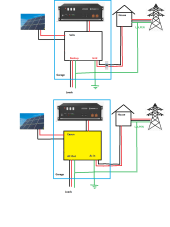I believe, as said in #8 and #10, it is technically possible. But, unless you have a very unusual, specific requirement that that solution would be sub optimal - especially with not much battery.
I guess the question is what are you exact power requirements first and then look at the best solution to achieve that aim.
e.g. is it to power the house
is it to provide backup in case of power cuts etc.?
I guess the question is what are you exact power requirements first and then look at the best solution to achieve that aim.
e.g. is it to power the house
is it to provide backup in case of power cuts etc.?



